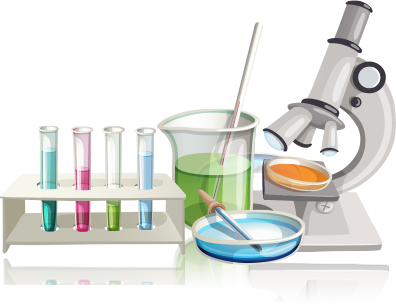It’s easy to tell the difference between hot and cold water just by feeling them. But they act differently in other ways too. Let's see what happens if you put hot water and cold water into room temperature water.
Here's what to do:
- Place a few ice cubes into a cup and add two tablespoons of water to make very cold water. Add 1 drop of blue food coloring to the cold water and gently mix.
- Ask your adult partner to add two tablespoons of hot tap water to a separate cup. Add 1 drop of red food coloring to the hot water and gently mix.
- Pour room temperature water into a taller clear plastic cup until it is about ¾-full.
- Your adult partner should use a dropper to pick up a dropper-full of cold blue water. Look at the room temperature cup from the side as your adult partner pokes the dropper about halfway into the water and slowly squeezes the cold blue water into the room temperature water.
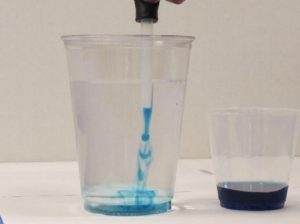
What do you observe? Does the cold blue water flow down to the bottom of the cup, stay near the middle, or float to the top?
- Next, your adult partner should use a dropper to pick up a dropper-full of hot red water. Look at the room temperature cup from the side as your adult partner pushes the dropper about halfway into the water and slowly squeezes the hot red water into the room temperature water.
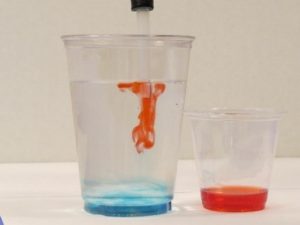
What do you observe? Does the hot red water sink down to the bottom of the cup, stay near the middle, or float to the top?
What to expect
The cold blue water will sink in the room temperature water and form a layer at the bottom of the cup. The hot red water will float to the surface of the room temperature water and form a layer at the top.
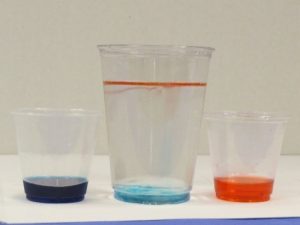
What's happening in there?
When water is cooled, the water molecules move slower and get closer together. This makes cold water more dense than room temperature water. Since cold water is more dense, it sinks in the room temperature water.
When water is heated, the water molecules move faster and spread out more. This makes hot water less dense than room temperature water. Since hot water is less dense, it floats on the room temperature water.
What else could you try?
When placed in room temperature water, hot water tends to move up and cold water tends to move down. What do you think would happen if you put hot water directly on top of cold water? Let’s try it and see!
What you'll need:
- 2 identical small clear glass or plastic jars (baby food jars work well)
- Ice water
- Hot tap water
- Thin stiff plastic card (laminated playing card or rectangle or square cut from yogurt or cottage cheese lid)
- Food coloring (red and blue)
Be safe
Be sure to review the safety instructions on page 1 before proceeding.
Here's what to do:
- Fill one jar completely to the brim with ice water. Add two drops of blue food coloring and gently stir to mix. Place this jar in a shallow pan or tray to catch any water that might spill.
- Your adult partner should fill another jar all the way to the brim with hot tap water. Add 2 drops of red food coloring and gently stir to mix.
- Your adult partner should place a plastic card over the hot water jar and turn it upside down, being sure to hold the plastic in place. Carefully place the card and hot water jar on top of the cold water jar so that the opening of the hot water jar is directly over the opening of the cold water jar.
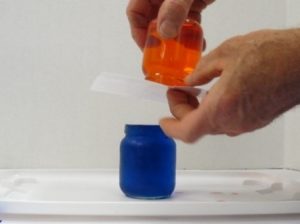
- Very carefully slide the plastic card out from between the jars while making sure that the openings of both jars are lined up so that as little water escapes as possible.
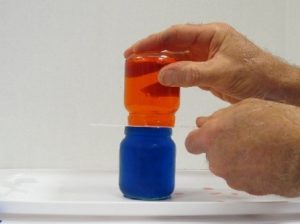
What do you observe? Do the hot water and cold water mix together? Why do you think this happens?
What to expect
The hot red water stays on top and the cold blue water stays on the bottom. There appears to be very little mixing where the hot and cold water meet.
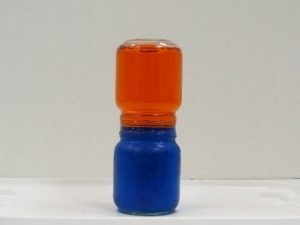
What's happening in there?
The hot water is less dense than the cold water so it floats on top of the cold water.
Think about this …
What do you think would happen if you switched the jars around? Try the experiment again but this time, first place the jar with the hot tap water (colored red) on the tray. Then place the plastic card on the cold water jar. Ask your adult partner to carefully turn the cold water jar over on the hot water jar and make sure the openings are lined up. Carefully slide the plastic from between the jars.
What happens? Can you explain it?
